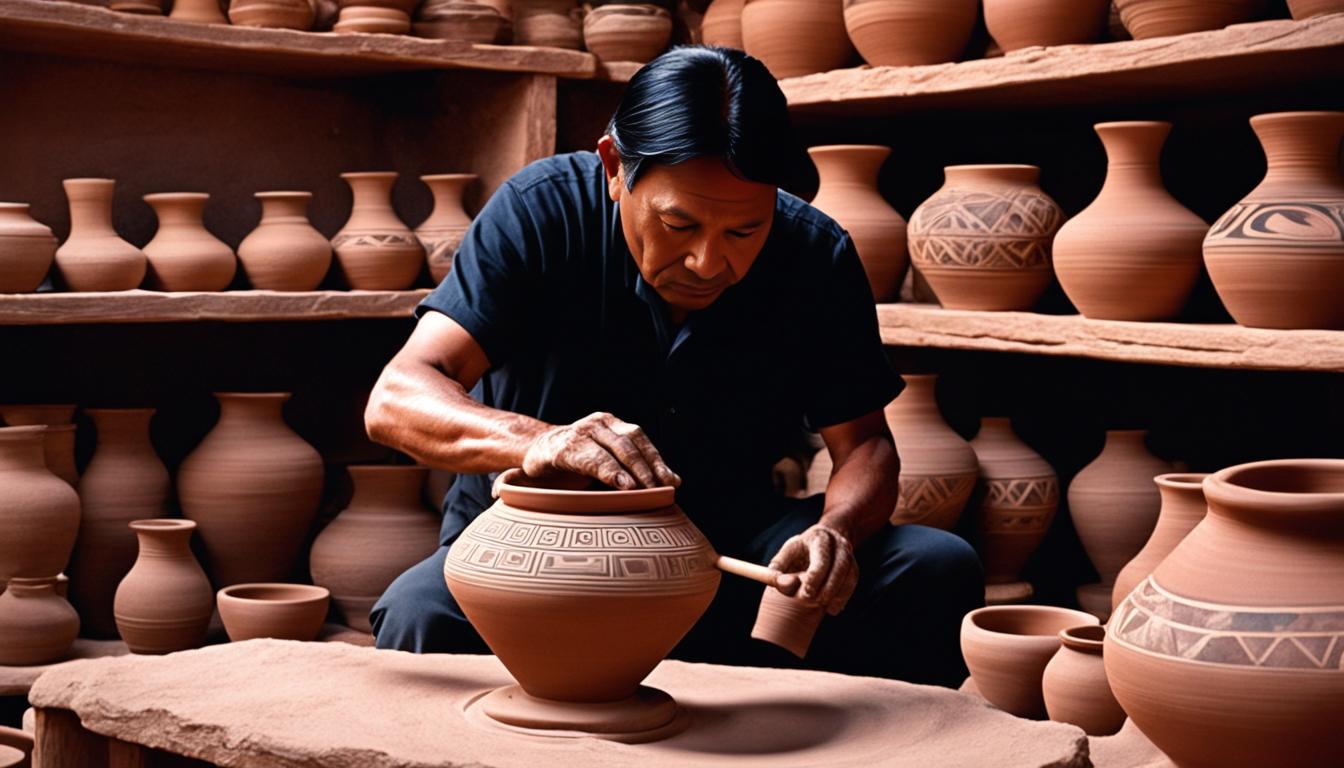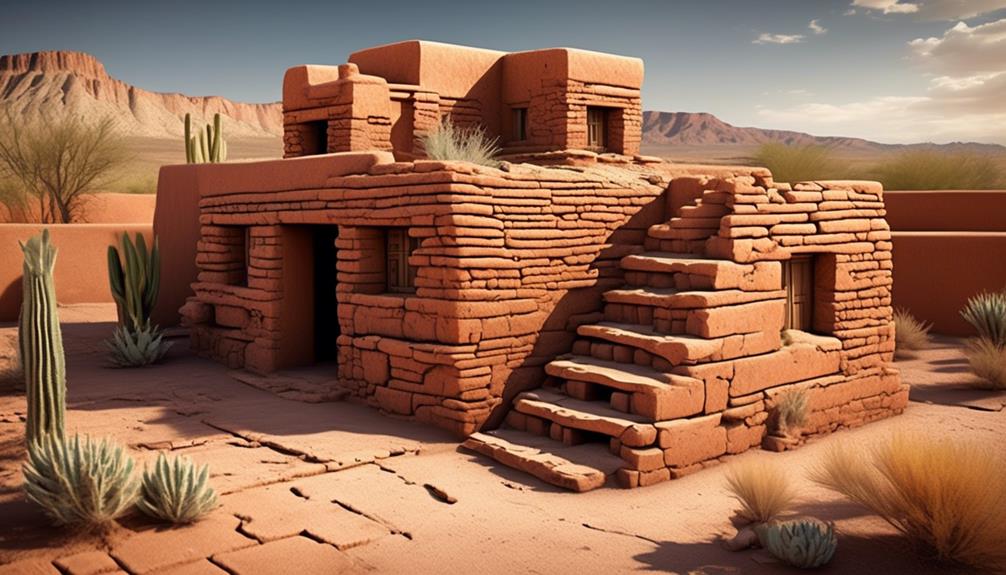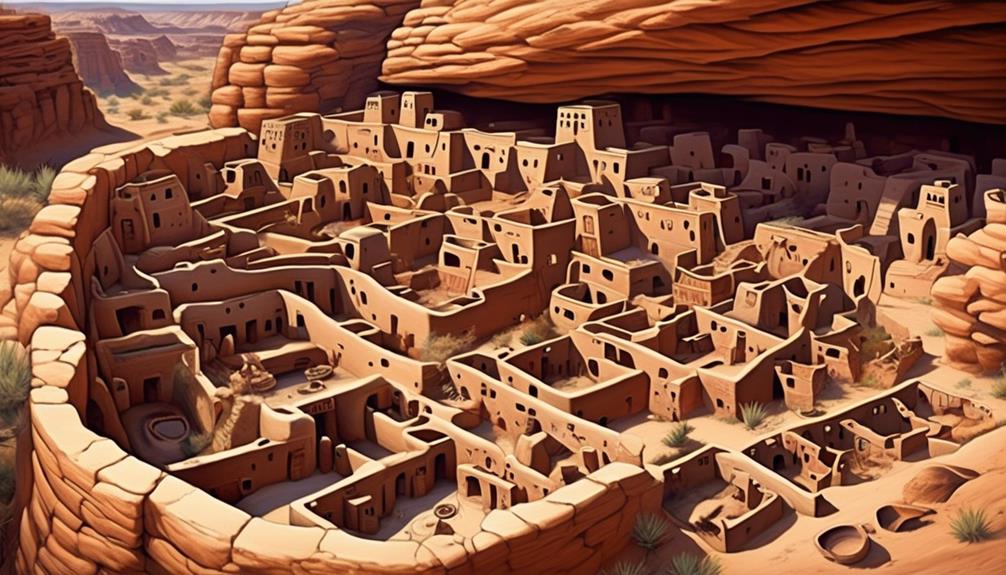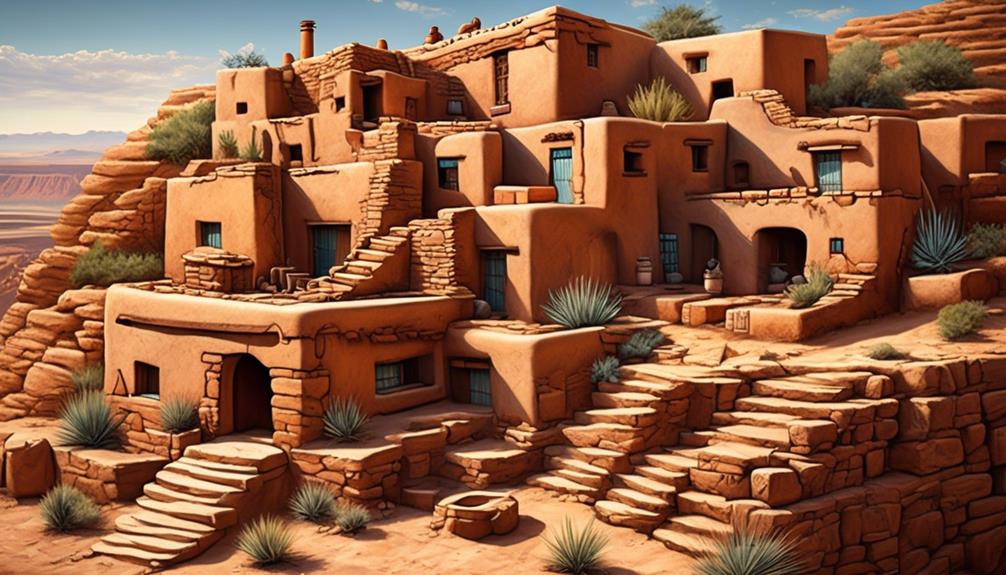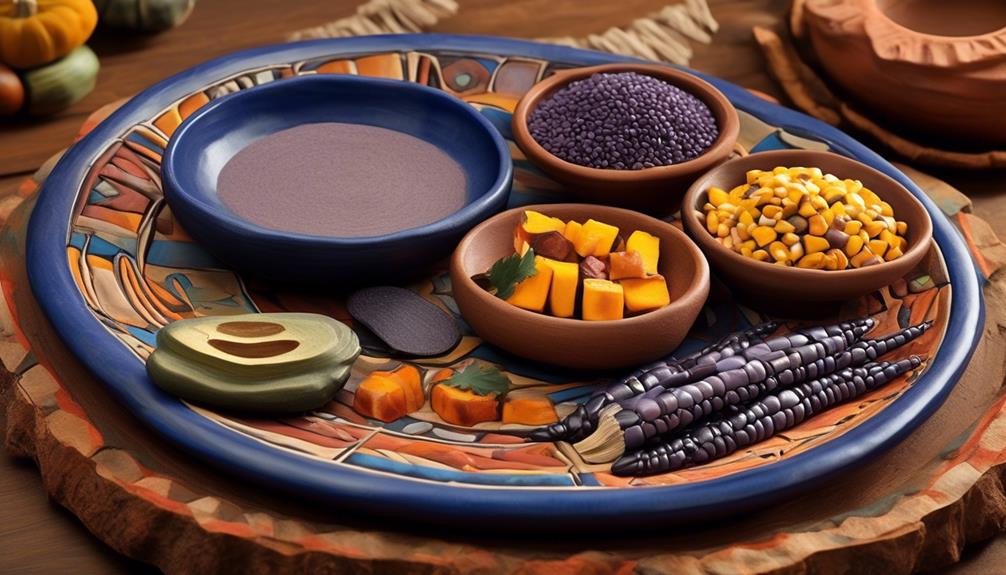Welcome to our exploration of the deep-rooted traditions and exemplary artistry of Hopi Tribe Pottery. The Hopi Tribe has been widely celebrated for their unique pottery, a craft that is deeply intertwined with their cultural heritage. Each piece highlights the skilled craftsmanship, intricate designs, and significant symbolism that distinguish Hopi pottery.
Key Takeaways:
- Hopi Tribe Pottery is renowned for its exceptional craftsmanship and cultural significance.
- The art form dates back over a thousand years and experienced a revival in the late 19th century.
- Hopi pottery is made using traditional techniques and features unique designs inspired by nature and traditional symbols.
- The pottery plays a significant role in everyday life and cultural events of the Hopi Tribe.
- Supporting Hopi pottery artists and purchasing authentic pottery contributes to the preservation of this timeless art form.
History of Hopi Pottery
Hopi pottery has a fascinating history that spans over a thousand years. This ancient art form holds deep cultural significance for the Hopi Tribe, showcasing their artistic traditions and heritage. Let’s delve into the captivating journey of Hopi pottery from its roots to its resurgence.
During the late 19th century, the discovery of ancient pottery shards in the Hopi region ignited a renewed interest in the traditional craft. These excavated fragments inspired Hopi potters to revive and innovate the time-honored techniques of their ancestors.
One of the most prominent figures in Hopi pottery history is Nampeyo, a talented potter who emerged during this revival period. Nampeyo’s exceptional skills and innovative designs played a crucial role in the resurgence of Hopi pottery. Her works became highly sought after, inspiring and influencing generations of Hopi potters to carry on the tradition.
“Hopi pottery is not just a beautiful art form; it is a way for us to connect with our ancestors and preserve our cultural heritage for future generations.” – Hopi Potter
Through dedication and perseverance, Hopi pottery has evolved and adapted over time, while still preserving its traditional roots. Today, Hopi potters continue to create stunning pieces that honor their history while embracing contemporary influences.
Stay tuned as we explore the traditional techniques, authentic designs, and the significance of symbols in Hopi pottery in our upcoming sections.
But first, let’s take a moment to appreciate the profound beauty of Hopi pottery. Take a look at this exquisite example of Hopi pottery below:
| Key Facets of Hopi Pottery History | Dates |
|---|---|
| Origins of Hopi pottery | Over a thousand years ago |
| Resurgence and innovation | 1890s |
| Significant potter: Nampeyo | 19th-20th century |
Traditional Hopi Pottery Techniques
Creating authentic Hopi pottery requires a mastery of traditional techniques that have been passed down through generations. These techniques involve a careful and meticulous process to shape and decorate each piece. Let’s explore the step-by-step process of crafting Hopi pottery.
Coil and Scrape Technique
The coil and scrape technique is the foundation of Hopi pottery. It involves building the pottery by adding coils of clay on top of each other to create the desired shape. The clay coils are joined together using slip, a mixture of clay and water, to ensure a strong bond. This technique allows potters to create various sizes and forms, from small bowls to large storage jars.
Decorating the Pottery
After the clay has dried and solidified, the surface of the pottery is smoothed using scraping tools. This not only gives the pottery a polished finish but also helps to remove any imperfections. Once the pottery is smooth, it is ready for decoration.
The intricate designs seen on Hopi pottery are created using mineral and vegetal paints. These paints are made from natural materials found in the Hopi land, such as iron-rich clays and mineral pigments. The paints are carefully mixed and then applied to the pottery using a yucca leaf brush. This brush allows for precise and delicate strokes, resulting in the detailed and beautiful designs that are characteristic of Hopi pottery.
Firing Process and Quality Inspection
The final step in creating Hopi pottery is the firing process. Traditionally, the pottery is fired outside over an open fire. This firing technique imparts a distinctive color and texture to the pottery, giving it a unique and authentic look.
Once the firing is complete, each piece of pottery is carefully inspected for quality and craftsmanship. Hopi potters take great pride in their work and ensure that each piece meets the highest standards.
Overall, the traditional techniques used in crafting Hopi pottery exemplify the skill, precision, and artistic vision of the Hopi Tribe. These techniques, passed down from one generation to the next, contribute to the preservation and continuation of this ancient art form.
| Traditional Hopi Pottery Techniques |
|---|
| Coil and Scrape Technique |
| Decorating the Pottery |
| Firing Process and Quality Inspection |
Authentic Hopi Pottery Designs
Hopi pottery is renowned for its exquisite designs that reflect the rich cultural heritage of the Hopi Tribe. The designs found on authentic Hopi pottery are deeply meaningful and often inspired by traditional symbols and natural elements. From intricate and realistic depictions to abstract and modern interpretations, Hopi pottery designs showcase the artistic prowess of the Hopi potters.
These designs draw inspiration from various sources, including:
- Traditional Symbols: Hopi pottery often features symbols that hold significant cultural and spiritual meaning. These symbols can represent elements such as rain, corn, animals, and katsinas, which are divine spirits in Hopi mythology. Each symbol tells a story and serves as a connection to the tribe’s history and beliefs.
- Nature Elements: The pottery designs also incorporate elements from the natural world. The Hopi people have a deep reverence for nature, and this is reflected in their artwork. Designs inspired by flora and fauna, such as plants, animals, and birds, can be found on Hopi pottery, showcasing the tribe’s close relationship with the environment.
Hopi pottery designs can range from traditional patterns that have been passed down through generations to contemporary interpretations that reflect the evolving artistic expressions of the Hopi potters. Each piece of pottery tells a unique story and captures the essence of Hopi culture and spirituality.
“The designs found on authentic Hopi pottery are deeply meaningful and often inspired by traditional symbols and natural elements.”
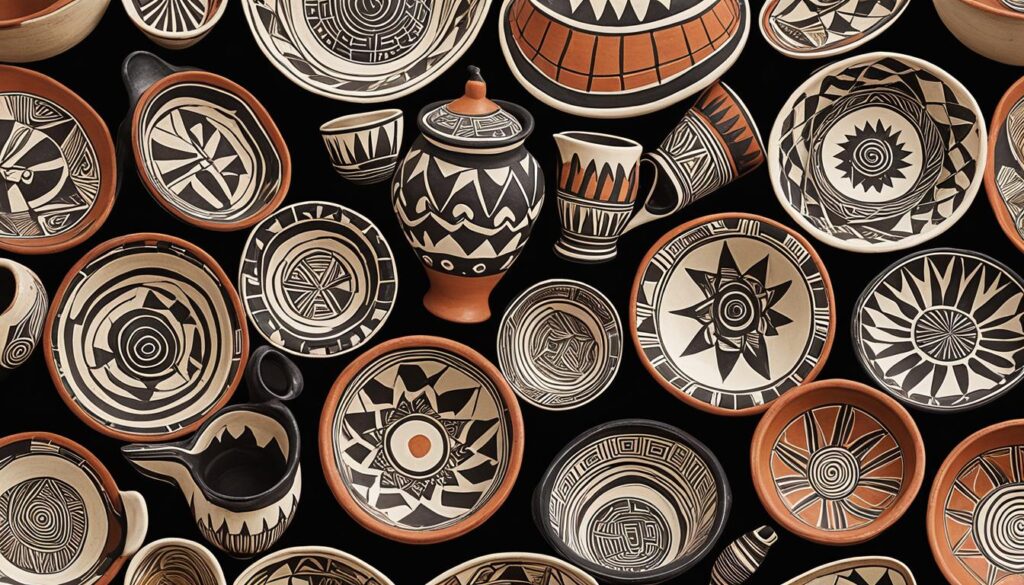
Hopi pottery designs showcase the talent and creativity of the Hopi potters, highlighting their mastery of traditional techniques and their ability to innovate and adapt. Whether it’s a beautifully painted ceramic bowl or a clay pot adorned with intricate geometric patterns, each design is a testament to the craftsmanship and artistic sensibilities of the Hopi people.
| Key Features of Hopi Pottery Designs | Examples |
|---|---|
| Intricate Details | |
| Symmetrical Geometric Patterns |  |
| Pictorial Depictions |
These examples showcase the diversity of Hopi pottery designs and the various artistic techniques employed by the Hopi potters. Each design is a reflection of the artist’s unique perspective and their personal interpretation of Hopi cultural motifs.
“Hopi pottery designs showcase the talent and creativity of the Hopi potters, highlighting their mastery of traditional techniques and their ability to innovate and adapt.”
Whether you’re a collector or simply appreciate the beauty and cultural significance of Hopi pottery, exploring the intricacies of the designs can be a fascinating journey into the heart of Hopi artistry.
Symbols in Hopi Pottery
Hopi pottery showcases a rich tapestry of symbols that carry profound cultural and spiritual significance. These symbols serve to represent various aspects of Hopi cosmology, tribal traditions, and historical events. Each symbol holds its own unique meaning, contributing to the preservation and transmission of the Hopi Tribe’s rich cultural heritage.
Symbolism and Cultural Significance
With deep reverence for their interconnectedness with nature and the spiritual realm, Hopi potters infuse their creations with powerful symbols. These symbols are passed down through generations and reflect the tribe’s core values, beliefs, and stories. By incorporating these symbols into their pottery, Hopi artisans imbue their work with a sense of continuity, honoring the traditions of their ancestors and ensuring their preservation for future generations.
“The symbols in Hopi pottery are carriers of our tribal stories, guiding us through our history and reminding us of our spiritual connection to the world around us.”
– Emma Qötsa, Hopi Potter
Common Symbols in Hopi Pottery
These are some of the most prevalent symbols found in Hopi pottery:
- Kokopelli: Depicted as a flute-playing figure, Kokopelli symbolizes fertility, abundance, and joy.
- Water Wave: Representing rainfall and water sources, the water wave signifies life, growth, and spiritual renewal.
- Butterfly: The butterfly symbolizes transformation, beauty, and the ephemeral nature of existence.
- Tadpole: Tadpoles evoke the cyclical nature of life, rebirth, and the emergence of new beginnings.
- Sunface: The sunface represents the source of light, warmth, and spiritual power.
The Language of Symbols
Hopi pottery symbols function as a visual language, speaking to the collective consciousness of the tribe and conveying complex narratives. Each symbol is carefully chosen and skillfully incorporated into the pottery, carrying the weight of centuries-old wisdom. The language of symbols transcends spoken words, inviting all who admire Hopi pottery to embark on a spiritual journey and engage with the profound cultural depth of the Hopi people.
Let us now delve into the world of Hopi pottery artists and explore their remarkable contributions to this revered tradition.
Hopi Pottery Artists
The Hopi Tribe is home to a multitude of exceptionally talented pottery artists who have mastered the craft of creating stunning and culturally significant pottery. From renowned potters like Nampeyo, whose contributions played a pivotal role in the revival of Hopi pottery, to the contemporary artists carrying on the tradition, each artist brings their unique style, creativity, and passion to their pottery creations. These talented individuals dedicate themselves to preserving the rich artistic heritage of the Hopi Tribe through their exquisite pottery.
Throughout the generations, Hopi pottery artists have honed their skills, expertly blending traditional techniques with their own artistic visions. Their craftsmanship is guided by a deep understanding of Hopi culture, history, and symbolism, resulting in pottery that is not only visually captivating but also laden with profound meaning and spiritual significance.
“The artistry of Hopi pottery lies not only in the precise technique but also in the connection to our cultural heritage, our stories, and our ancestors. Each pot we create is an expression of our identity and serves as a vessel to carry our traditions into the future.” – Hopi Potter
Influential Hopi Pottery Artists
Several notable Hopi pottery artists have made significant contributions to the art form, leaving a lasting impact on the cultural landscape. These artists have not only achieved recognition within the Hopi Tribe but also garnered acclaim beyond their community.
- Nampeyo: An iconic figure in Hopi pottery history, Nampeyo’s work revolutionized Hopi pottery aesthetics and techniques. Her innovative designs and ability to merge tradition with creativity laid the foundation for the revival of Hopi pottery in the late 19th century.
- Alfred Navasie (Hopi-Tewa): Known for his exceptional craftsmanship and intricate designs, Alfred Navasie earned recognition as one of the most respected Hopi-Tewa potters.
- Dextra Quotskuyva Nampeyo: Continuing the artistic legacy of her great-grandmother, Nampeyo, Dextra Quotskuyva Nampeyo is celebrated for her contemporary interpretations of traditional Hopi pottery.
The artwork of these talented Hopi pottery artists can be found in galleries, museums, and private collections around the world. Their dedication and skill have elevated Hopi pottery to a revered art form, showcasing the rich cultural heritage of the Hopi people.
Importance of Hopi Pottery in Everyday Life
Hopi pottery holds a special place in the daily lives of the tribe, serving both practical and cultural purposes. It plays a vital role in various aspects of Hopi life, connecting the present generation with their history and traditions. The pottery is not just a functional item; it holds deep meaning and significance for the Hopi people.
Practical Utilization of Hopi Pottery
The mastery of Hopi potters is reflected in the pottery’s versatility and usefulness in everyday life. The skillfully crafted vessels are employed in practical tasks including:
- Serving and storing food
- Transporting water
- Cooking over open fires
- Preserving grains
The durability and efficiency of Hopi pottery make it an indispensable part of the tribe’s everyday activities.
Cultural Significance of Hopi Pottery
Hopi pottery carries immense cultural value, as it is intimately connected to the tribe’s customs, ceremonies, and religious practices. The pottery is used in various cultural events such as:
- Katsina dances and ceremonies
- Weddings and initiations
- Burial rituals
- Blessings and prayers
During these occasions, the pottery serves as both a vessel and a symbolic representation of the tribe’s beliefs and traditions. It embodies the spiritual connection between the Hopi people, their ancestors, and the natural world.
“Hopi pottery is not just an object; it’s a vessel that carries our stories, our heritage, and our identity as a tribe.”
Through the artistry of the Hopi potters, these vessels become conduits for the transmission of cultural knowledge and keepers of the Hopi people’s collective memory.
Hopi Pottery in Contemporary Life
Even in the modern world, Hopi pottery retains its significance and continues to play a prominent role in Hopi cultural identity. The pottery serves as a reminder of their roots, connecting the Hopi people to their ancestors and maintaining a sense of belonging. It is a powerful testimony to the tribe’s resilience, adaptability, and devotion to preserving their heritage.
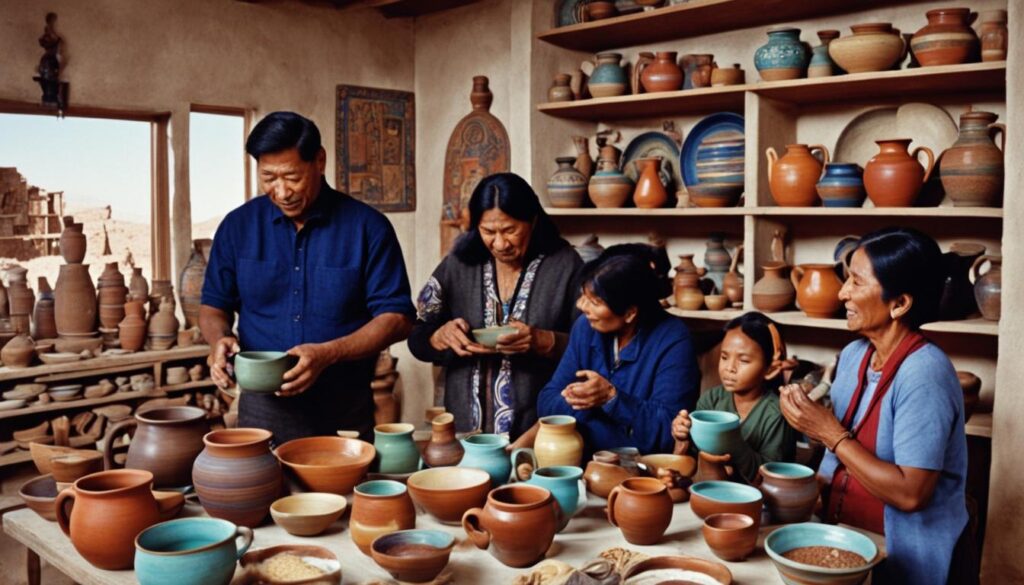
| Everyday Uses of Hopi Pottery | Cultural Significance of Hopi Pottery |
|---|---|
| Serving and storing food | Katsina dances and ceremonies |
| Transporting water | Weddings and initiations |
| Cooking over open fires | Burial rituals |
| Preserving grains | Blessings and prayers |
Hopi Pottery for Sale
If you’re interested in owning a piece of authentic Hopi pottery, you’re in luck! There are numerous galleries and shops specializing in Native American art where you can find exquisite Hopi pottery for sale. When making a purchase, it’s crucial to source your pottery from reputable sources to ensure the authenticity and quality of the artwork.
By investing in Hopi pottery, not only do you support the talented Hopi artists, but you also play a significant role in preserving their cultural heritage. Each piece of pottery represents the traditions, craftsmanship, and spiritual significance of the Hopi Tribe.
Whether you’re a seasoned collector or a newcomer to Native American art, acquiring Hopi pottery is a wonderful way to appreciate and connect with the artistic traditions of the Hopi people. Each piece tells a story and carries with it a sense of history and cultural identity.
“Owning Hopi pottery is like holding a piece of heritage in your hands. Each beautifully crafted piece serves as a testament to the depth and richness of the Hopi cultural legacy.” – Hopi Art Collector
When purchasing Hopi pottery, take the time to educate yourself about the different styles, designs, and symbolism seen in these artworks. This knowledge will not only enhance your appreciation but also enable you to make informed choices that align with your personal preferences and interests.
Why Buy Hopi Pottery
Here are a few reasons why investing in Hopi pottery is a meaningful and valuable addition to your collection:
- Historical Significance: Hopi pottery has a rich history dating back centuries, making each piece a tangible connection to a vibrant past.
- Cultural Preservation: By supporting Hopi artists and purchasing their pottery, you contribute to the preservation and continuation of an ancient art form.
- Artistic Excellence: Hopi pottery is renowned for its exquisite craftsmanship, attention to detail, and unique designs inspired by traditional symbolism.
- Spiritual and Symbolic Meaning: Each pottery piece carries deep cultural and spiritual significance, reflecting the cosmology, traditions, and legends of the Hopi Tribe.
- Uniqueness and Authenticity: Genuine Hopi pottery is a one-of-a-kind artwork created by skilled artists who have inherited and mastered the techniques passed down through generations.
How to Choose Hopi Pottery
When selecting Hopi pottery for your collection, keep these considerations in mind:
- Authenticity: It’s essential to purchase from reputable sources that guarantee the authenticity of the pottery.
- Quality: Examine the craftsmanship, fine details, and overall condition of the piece to ensure its quality.
- Design and Symbolism: Appreciate the unique designs and symbolism incorporated into the pottery, representing the artist’s creativity and cultural heritage.
- Artist Recognition: Research renowned Hopi potters whose work you admire and seek out their pieces.
- Display and Care: Consider where and how you will display your acquired pottery, ensuring it receives the care it deserves.
By carefully selecting and displaying Hopi pottery, you bring the beauty and significance of this ancient art form into your home, creating a space filled with cultural richness and artistic charm.
| Benefits of Hopi Pottery | Considerations |
|---|---|
| Preserves Hopi cultural heritage | Source from reputable sellers |
| Showcases artistic excellence | Examine craftsmanship and quality |
| Connects with Hopi traditions and spirituality | Appreciate the design and symbolism |
| Unique and one-of-a-kind artworks | Research renowned Hopi potters |
Start your journey into the captivating world of Hopi pottery by acquiring an authentic piece that speaks to your soul. Embrace the cultural richness, artistic beauty, and timeless heritage encapsulated in every carefully crafted Hopi pottery creation.
Appreciating the Craftsmanship of Hopi Pottery
The craftsmanship of Hopi pottery is truly remarkable, showcasing the talent and dedication of the Hopi potters. Every piece of pottery reflects their attention to detail, intricate designs, and skilled techniques. By appreciating and collecting Hopi pottery, we not only recognize its artistic value but also become a part of the ongoing preservation of this ancient art form.
Hopi pottery is created using traditional methods that have been passed down through generations. The potters skillfully mold the clay into unique shapes using the coil and scrape technique. Each coil is carefully added to create the desired form, and the pot is then meticulously smoothed and dried.
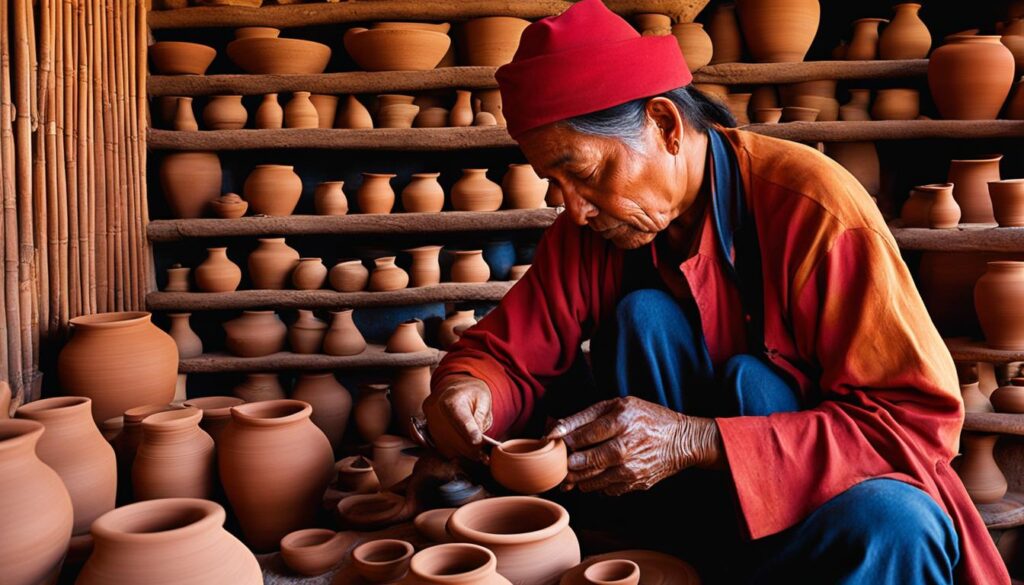
The potters also incorporate stunning designs that are inspired by their cultural heritage. From traditional symbols to representations of nature and katsinas, each design tells a story and holds deep meaning.
The final step in the pottery-making process is the firing. Hopi pottery is traditionally fired outdoors, using a combination of wood and cow dung, which gives the pots their unique colors and textures. The firing process requires great skill and attention to detail, as the temperature and duration must be carefully controlled to produce the desired results.
The end result is a beautiful piece of pottery that captures the essence of Hopi culture and craftsmanship. The intricate designs, vibrant colors, and flawless execution make Hopi pottery truly exceptional.
Each piece of Hopi pottery is a testament to the artistic mastery and cultural significance of the Hopi potters.
Table: Examples of Hopi Pottery Designs and Their Meanings
| Design | Meaning |
|---|---|
| Kokopelli | Represents fertility, joy, and the spirit of music |
| Eagle | Symbolizes strength, courage, and divine protection |
| Water Wave | Signifies the importance of water and the vital role it plays in Hopi life |
| Butterfly | Represents transformation, beauty, and the ephemeral nature of life |
By appreciating the craftsmanship of Hopi pottery, we honor the skill and passion of the potters while also supporting the preservation of this ancient art form. Whether displayed as a beautiful centerpiece or used in everyday life, Hopi pottery serves as a tangible link to the rich cultural heritage of the Hopi Tribe.
Hopi Pottery Appraisals
If you own Hopi pottery and are interested in knowing its value, we recommend seeking professional appraisals from experts in Native American art and pottery. Appraisals can provide valuable insights into the artist, age, historical significance, and current market value of your piece.
Working with reputable appraisers who have expertise in Hopi pottery is crucial to ensure accurate evaluations. These experts possess a deep understanding of the craftsmanship, symbolism, and cultural heritage associated with Hopi pottery.
During the appraisal process, the appraiser will carefully examine your piece, considering factors such as the quality of the clay and craftsmanship, the intricacy of the designs, and any unique markers or symbols. They will also consider the historical context and artist’s influence on the value of the pottery.
Appraisals provide insights into the artist, the age and historical significance of the piece, and its current market value.
Once the appraisal is complete, you will receive a detailed report that highlights the unique qualities of your Hopi pottery and an estimated value based on market trends and expert knowledge. This information can be invaluable if you are considering selling the piece or for insurance purposes.
Remember, authentic Hopi pottery holds significant cultural and historical value, and having it appraised by experts ensures its preservation and recognition in the art world.
Connect with reputable appraisers who specialize in Hopi pottery and gain a deeper understanding of your cherished piece today.
Preserving the Legacy of Hopi Pottery
The preservation of Hopi pottery is crucial for maintaining the cultural heritage of the Hopi Tribe. Efforts are being made to document and protect traditional techniques, encourage young artists to continue the craft, and educate the public about the significance of Hopi pottery.
By raising awareness and supporting initiatives, we can contribute to the long-term preservation of this timeless art form.
Documenting Traditional Techniques
To ensure the preservation of Hopi pottery, it is vital to document the traditional techniques used by Hopi potters. By recording and cataloging the methods passed down through generations, we can safeguard the knowledge and skills involved in this ancient craft.
Supporting Young Artists
Encouraging young artists to embrace and continue the art of Hopi pottery is essential for its long-term preservation. Providing mentorship programs and opportunities for training can help cultivate the next generation of skilled Hopi potters, ensuring the continuity of the craft.
Educating the Public
By educating the public about the significance of Hopi pottery, we can foster a deeper appreciation for this art form and its cultural importance. Through exhibitions, workshops, and educational programs, we can promote understanding and respect for Hopi pottery’s historical and cultural significance.
“Preserving the legacy of Hopi pottery is a collective effort that requires the support of individuals, communities, and institutions. Together, we can ensure that this remarkable art form continues to thrive for future generations.”
By actively preserving Hopi pottery, we honor the traditions and craftsmanship of the Hopi Tribe, preserving their cultural heritage for years to come.
Exploring Hopi Arts and Crafts
Hopi pottery is just one aspect of the vibrant arts and crafts produced by the Hopi Tribe. They are also known for their woven items, such as baskets and textiles, as well as their intricate Kachina dolls. These creations reflect the deep connection between art, spirituality, and everyday life for the Hopi people.
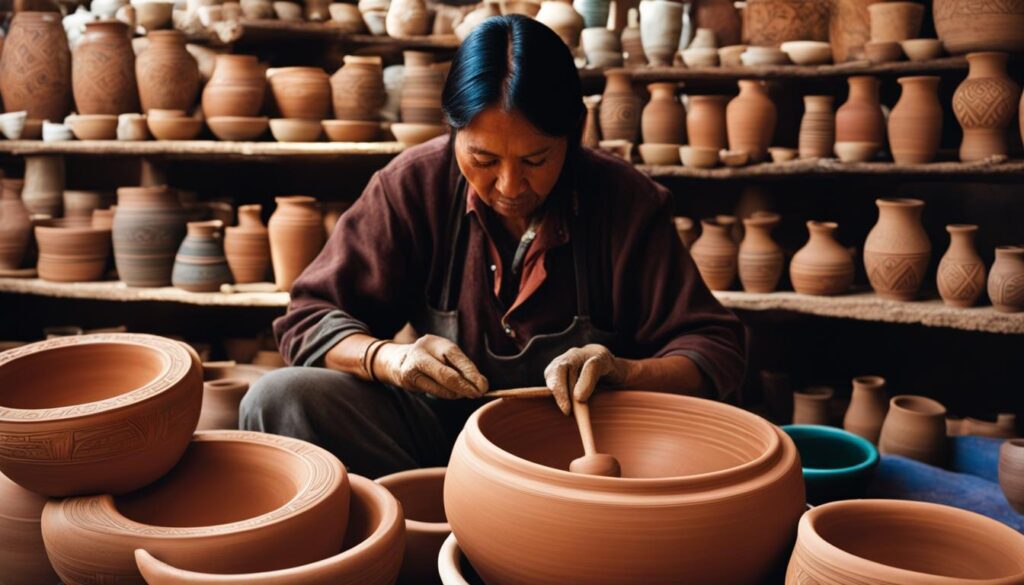
The Hopi Tribe’s artistic traditions extend beyond pottery, encompassing a wide range of crafts that showcase their cultural heritage. Hopi baskets are intricately woven using natural materials like grasses, yucca leaves, and sumac stems. The baskets serve various practical purposes, from storage to winnowing seeds. Collectors admire Hopi baskets for their exquisite designs and meticulous craftsmanship.
Hopi textiles also play a significant role in Hopi artistry. Traditionally woven by men using native cotton and natural dyes, Hopi textiles include belts, sashes, blankets, dresses, and ceremonial kilts. The designs often incorporate Hopi symbols and patterns, serving as a visual representation of the tribe’s cultural heritage and artistic skills.
Furthermore, the Hopi Tribe is renowned for their Kachina dolls. These carved figures represent different Katsina spirits in Hopi mythology and play a vital role in religious ceremonies. Each Kachina doll is meticulously crafted and painted by hand, illustrating the incredible skill and creativity of the Hopi artisans.
Through their arts and crafts, the Hopi people express their profound spirituality and connection to the natural world. Each piece carries stories, traditions, and symbolic meaning that reflect the tribe’s rich cultural tapestry. By exploring and appreciating Hopi arts and crafts, we gain a deeper understanding of their heritage and contribute to the continued preservation of this extraordinary cultural legacy.
Traditional Hopi Basketry
Hopi basketry is a traditional craft that has been practiced by the Hopi Tribe for generations. It involves the skillful weaving of baskets using natural materials such as grasses, yucca leaves, and sumac stems. The intricate designs and high level of craftsmanship exhibited in Hopi baskets make them highly sought after by collectors.
Basketry serves a variety of practical purposes in Hopi culture. The baskets are used for storage, carrying items, and even winnowing seeds. They showcase the resourcefulness and creativity of the Hopi people, who have mastered the art of transforming natural materials into functional and aesthetically pleasing objects.
The weaving process requires patience and precision. Hopi basket weavers carefully select and prepare the materials, ensuring they are durable and flexible. The weaving technique allows for the creation of intricate patterns and designs, reflecting the rich cultural heritage of the Hopi Tribe.
| Key Features of Hopi Basketry | Significance |
|---|---|
| Intricate Designs | The intricate designs in Hopi baskets often depict symbolic patterns and motifs that have cultural and spiritual significance. |
| High Level of Craftsmanship | Hopi baskets are meticulously woven with attention to detail, showcasing the exceptional craftsmanship of the weavers. |
| Functional and Aesthetic | Hopi baskets serve practical purposes while also being visually appealing, making them both useful and decorative. |
The art of Hopi basketry is passed down from generation to generation, with elders teaching younger tribal members the techniques and traditions associated with this craft. It is a way of preserving and honoring the cultural heritage of the Hopi Tribe.
Collectors and enthusiasts value Hopi baskets for their historical and cultural significance. They are considered valuable pieces of art that represent a rich tradition and have a unique story to tell. Owning a Hopi basket allows us to appreciate the skill and artistry of the Hopi weavers while supporting their ongoing cultural preservation.
Quote:
“Hopi basketry embodies the skill and ingenuity of our ancestors. Each basket tells a story and connects us to our cultural heritage.” – Hopi Tribal Elder
Hopi Textiles
Hopi textiles are a vibrant representation of the artistic skills and cultural heritage of the Hopi people. The tribe’s skilled weavers create a variety of textile items, including belts, sashes, blankets, dresses, and ceremonial kilts. These textiles are woven using native cotton and natural dyes, highlighting the tribe’s commitment to traditional craftsmanship and sustainable practices.
The designs found in Hopi textiles often incorporate symbols and patterns that hold deep cultural significance. These motifs reflect the tribe’s rich history, spiritual beliefs, and connection to the natural world. Each textile tells a story, preserving the traditions and values of the Hopi tribe for generations to come.
Traditional Hopi Weaving Techniques
“Hopi weaving is a skill that has been passed down through generations, with each weaver contributing their unique creativity and expertise to the art form.”
The weaving of Hopi textiles is traditionally done by men, who have been the primary weavers in the tribe for centuries. These skilled craftsmen use a variety of weaving techniques, including tapestry and warp-faced weaving, to create intricate and durable textiles.
Hopi weavers utilize natural materials such as cotton and wool, which are often hand-spun to ensure quality and authenticity. The fibers are carefully dyed using natural pigments sourced from plants, insects, and minerals, resulting in a rich and varied color palette.
Symbolism in Hopi Textiles
The designs and patterns in Hopi textiles are not merely decorative; they carry profound meaning rooted in Hopi cosmology and tribal traditions. Common symbols found in Hopi textiles include representations of katsinas (divine spirits), corn, rain, and other elements of the natural world.
For example, the geometric patterns seen in many Hopi textiles symbolize the interconnectedness of all things and the cyclical nature of life. These symbols communicate the tribe’s spiritual beliefs, values, and identity, providing a visual language that transcends time and connects the present with the ancestral past.
Preserving Hopi Textiles
The preservation of Hopi textiles is of utmost importance to the Hopi people, as these textiles encapsulate their cultural heritage and artistic legacy. Efforts are being made to document and protect traditional weaving techniques, ensure the sustainability of natural dye sources, and promote the continuation of this ancient craft.
By appreciating and supporting Hopi textiles, we contribute to the preservation and celebration of the Hopi cultural legacy. Whether displayed as works of art or cherished as functional items, these textiles serve as a testament to the resilience, creativity, and enduring spirit of the Hopi people.
| Symbol | Meaning |
|---|---|
| Katsina | Representation of divine spirits and ancestral guidance |
| Corn | Symbol of fertility, sustenance, and the agricultural cycle |
| Rain | Signifies prosperity, renewal, and the essential role of water |
| Geometric Patterns | Reflect the interconnectedness of all things and the cyclical nature of life |
Conclusion
Hopi Tribe Pottery is not just a craft; it is a testament to the rich cultural heritage and artistic traditions of the Hopi Tribe. The intricate designs, symbolic motifs, and exceptional craftsmanship of Hopi pottery tell stories of generations past and connect us to a vibrant history.
By appreciating, collecting, and supporting Hopi pottery, we become custodians of this ancient art form, contributing to its preservation and ensuring its continuation for future generations. The purchase of authentic Hopi pottery not only rewards the talented artists who dedicate their lives to this craft but also helps sustain the cultural legacy of the Hopi Tribe.
As we marvel at the colors and patterns adorning each clay vessel, we can feel a profound sense of connection to the Hopi people, their traditions, and the natural world that inspires their creations. Let us honor their artistry by celebrating and cherishing Hopi pottery as a living testament to the resilience and beauty of indigenous cultures.
FAQ
What is the history of Hopi pottery?
Hopi pottery has a rich history that dates back over a thousand years. It experienced a resurgence in the 1890s when ancient pottery shards were excavated, inspiring Hopi potters to revive and innovate the traditional style.
How is Hopi pottery made?
Hopi pottery is handmade using the coil and scrape technique, with coils of clay added to create the desired shape. The pottery is then smoothed using scraping tools and dried before the application of designs. Mineral and vegetal paints are used, applied with a yucca leaf brush. The firing process takes place outside over a fire.
What are the designs in Hopi pottery inspired by?
The designs in Hopi pottery are often inspired by traditional symbols and nature elements such as rain, corn, animals, and katsinas (divine spirits).
What do the symbols in Hopi pottery represent?
The symbols in Hopi pottery represent various aspects of Hopi cosmology, tribal traditions, and historical events. Each symbol has its own meaning and helps to preserve and pass on the cultural heritage of the Hopi Tribe.
Who are some notable Hopi pottery artists?
There are many talented Hopi pottery artists, including renowned potters like Nampeyo, who played a crucial role in the revival of Hopi pottery, as well as contemporary artists who carry on the tradition with their unique style and creativity.
How is Hopi pottery used in everyday life?
Hopi pottery is used for practical purposes such as serving food and carrying water, as well as for ceremonial and cultural events. It serves as a connection to the tribe’s history and traditions and is an essential part of Hopi cultural identity.
Where can I buy authentic Hopi pottery?
Authentic Hopi pottery is available for sale in various galleries and shops that specialize in Native American art. It is important to purchase pottery from reputable sources to ensure authenticity and quality.
What makes Hopi pottery craftsmanship exceptional?
Hopi pottery craftsmanship is admired for its attention to detail, intricate designs, and skilled techniques. Each piece reflects the dedication, talent, and cultural significance of the Hopi potters.
How can I get my Hopi pottery appraised?
If you own Hopi pottery and are interested in knowing its value, you can seek professional appraisals from experts in Native American art and pottery. Reputable appraisers can provide insights into the artist, age, historical significance, and current market value of the piece.
How can we preserve the legacy of Hopi pottery?
Efforts are being made to document and protect traditional techniques, encourage young artists to continue the craft, and educate the public about the significance of Hopi pottery. By raising awareness and supporting initiatives, we can contribute to the long-term preservation of this ancient art form.
What other arts and crafts are produced by the Hopi Tribe?
The Hopi Tribe is known for their woven items, such as baskets and textiles, as well as their intricate Kachina dolls. These creations reflect the deep connection between art, spirituality, and everyday life for the Hopi people.
Source Links
- https://www8.nau.edu/hcpo-p/pottery.html
- https://scalar.usc.edu/works/american-indian-film-archive/hopi-arts-and-crafts
- https://www.indiancraftshop.com/ARCHIVES/Arts_of_the_Hopi.htm
Talise is a talented writer and an expert in her field. Her unique perspective and insights enrich our content with depth and authenticity. With a wealth of knowledge and a strong connection to the subjects she writes about, Talise crafts engaging and informative articles that resonate with our readers. Her dedication to bringing Indigenous culture and wisdom to light is truly commendable.
